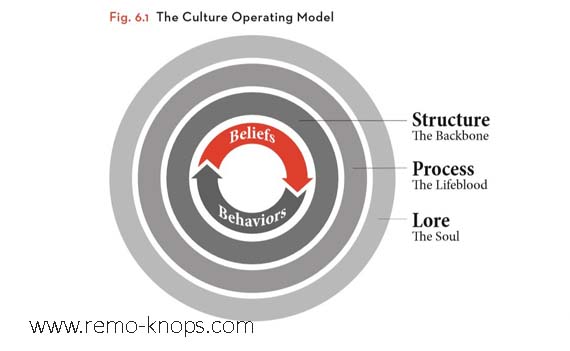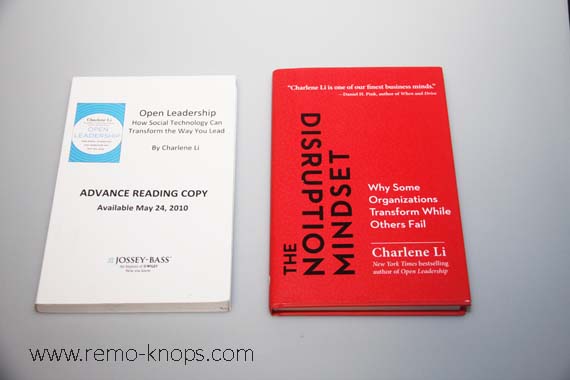In this article I will review The Disruption Mindset which is the latest book from Charlene Li. While in the field of open innovation the term disruption is a common term I was pretty excited to learn how a disruptive mindset and a disruptive company culture can be developed.
So I will start by going through the book structure and highlight a couple of sections and paragraphs that were most exciting or relevant to my in my current state of personal- and professional development.
TABLE OF CONTENTS
The Disruption Mindset Book Structure
“If disruptive transformation is the process you go through, the outcome at the other end is what makes it worth the journey: exponential growth. Let me be clear that I define growth broadly.”
Charlene starts with an introduction where she covers a definition, the result and the key elements of “disruptive transformation“:
- A strategy inspired by future customers to make big-gulp decisions;
- Leadership that creates a movement of disruptors
- A culture that thrives with disruption
Strategy, leadership and culture are often elements of transformational processes (at least to my experience), where cultural change or shift is probably the most difficult element to fully drive.
Since the book “Design a Better Business” I see multiple people around the globe with a common interest is exponential growth or exponential business models (remark Peter Diamandis who introduced the term 10x. Charlene also states that exponential growth should be the result of the disruptive transformation (process).
The main body of the book consists of 6 chapters that are stated in the table below.
| # | CHAPTER DESCRIPTION | PAGE |
|---|---|---|
| 01 | The Simple Secret of Successful Disruptive Strategies | 17 |
| 02 | Preparing For the Big-Gulp Moment | 45 |
| 03 | Leading a Disruptive Movement | 69 |
| 04 | Developing Disruptive Leaders | 99 |
| 05 | Disrupting Your Culture | 125 |
| 06 | The Flux Culture Operating System | 157 |
The Simple Secret of Successful Disruptive Strategies
The first chapter is based around the question “Who is your future customer?” or as the Business Models Inc team states “Focus on where the value is created next.“
In addition to the advantages when you focus on your future customers, Charlene shares some best practices when identifying your future customers.
- Put customers in your dashboards;
- Spark curiosity about customers;
- Create a customer advisory board;
- Find your customer-obsessed staff;
- Define your future customer with research, not hearsay;
These best practices are clarified with some good examples, so these will stick.
In all fairness this doesn’t sound like rocket science when you have some business sense. 🙂 However putting these best practices into every day operations is more challenging.
Preparing For the Big-Gulp Moment
This chapter of the book has three parts.
- Build the case with rigorous research;
- Secure buy-in with transparency;
- Burn the boats so there’s no turning back;
However I can best describe the contents with a sports example. You set the goal for participating in a sports event, and you need to put in the training efforts and research for optimal performance gains. In order to properly prepare you need to get the buy-in from your friends and family and on the event itself … when you are waiting at the starting-line, there is no turning back. Go all-in and deliver the best sports performance on that day.
Similar steps need to be done, when you prepare for creating a disruptive movement. You need to do your research (that contains both quantitative and qualitative data), you need to convince key stakeholders and get them on-board, and when you start your burn the boats and move in the only direction possible … “forward”.
Leading a Disruptive Movement
If you want to lead a disruptive movement it is crucial to understand the different types of followers and how to connect and relate with them.
Charlene Li has identified five different types of followers there are pictured above. The different follower types are plotted in a 2×2 matrix, where independent, critical thinking and active followers are the most effective type.
- Identify followers and define your relationship with them;
- Write a manifesto that inspires action;
- Sustain a consistent leadership presence;
In addition to the identification you can also see that leadership and a consistent presence are highly important.
Developing Disruptive Leaders
If you want to start a disruptive movement of followers, you will need leaders with a disruptive mindset. Of course not all leaders have a disruptive mindset, and there are various leadership styles and leadership types.
Charlene Li identified four Disruptive Leadership Archetypes (p.109) based on the openness to change and the behaviors that inspire and empower followers.
The Disruptive Leader of the realist optimist archetype has the highest disruptive quotient. However the percentage of this archetype of disruptive leaders is just 27%. So there is a unique leadership role to keep in mind, when you want to build experience to become this disruptive leader in your company or ecosystem.
Disrupting Your Culture
“Being on the right side of disruption requires having not just the right strategy, but also the culture and leadership to execute it.”
This is the first sentence of chapter 5, that continues with the story of McKinsey. Charlene Li furthermore introduces the beliefs of flux cultures and the fact that beliefs and behaviors define an organization’s culture.
“Flux cultures instead build a foundation of trust and safety, giving people the emotional strength to confidently push into the unknown and take audacious risks. People will disrupt and radically transform how they work and do things only if they feel safe, because emotions, not logic, drive change.”
On the contrary she also introduces the stuck culture, which is the opposite of a Flux Culture. 🙂
“The opposite is a “stuck culture,” one that is stuck in the status quo and fails to nurture its employees’ ability to handle the kind of massive change that’s needed to support a disruptive strategy.”
While no culture is good or bad, it is more a matter if you fit with the shared beliefs and take the actions in line with the company’s behaviors. Charlene Li however shows the differences how each culture type challenges its employees.
Based upon her research and past books Charlene comes up with three fundamental beliefs of a Flux Culture:
- Openness Belief – Openness to create a foundation of trust;
- Agency Belief – Giving permission to act like owners;
- Action Belief – Working at the speed of opportunities;
Charlene Li provides the reasoning why and the impact of having the belief in place (for each of the three beliefs). Case studies also clarify the model with practical examples.
The Flux Culture Operating System
“Process drives culture, not the other way around, so you can’t just change the culture, you have to change the system.” — Eric Reis
When you talk about operating models and management systems please check out the reviews of:
- “Operating Model Canvas – Aligning operations and organization with strategy” by Andrew Campbell et all.
- Process Model Canvas by David Ruting et. all.
“Without the disruption operating system, you can’t coordinate and leverage the scale and power of your organization.”
The case study used in this chapter is “Microsoft hits the refresh button.” which is very similar to Satya Nadella’s book Hit Refresh. Having worked for Microsoft Netherlands I could first hand experience the move to the transformation towards a cloud first mobile first mission (and thus operating modus of the business). In addition I was fortunate to experience the difference between Steve Ballmer and Satya Nadella.
Charlene Li also describes a culture operating model, where beliefs and behaviors are at the core of the culture.
- Structure is the backbone of the operating system;
- Processes are the lifeblood of the operating system;
- Lore with it rituals and symbols is the soul of the operating system;
In this section of the book ING Bank is also one of the cases described.
Concluding thoughts and wrap-up
In this fast moving world where exponential technologies drive disruption it is interesting to read The Disruption Mindset and tap into Charlene’s look on “why some organizations transform, while others fail.”
The Disruption Mindset is a logical next step, when you look at the previous books of Charlene. It is building further upon the knowledge from Groundswell (published in 2008) on-wards, that combines all the knowledge that Charlene gathered in 12 years of research.
In 2010 I published a book review on the book: “Open Leadership – How social technology can transform the way you lead.” A couple of months later I started working for Microsoft Netherlands, simply because the topic helped me to connect with one of the executives.
In the year that Clayton Christensen, the “founder” of disruptive innovation, passed away I connected again with Charlene about The Disruption Mindset. I was fortunate to receive a digital review sample of The Disruption Mindset.
The book is packed with a lot of interesting angles on creating a movement and driving cultural change. So if (digital) transformation, change management and cultural change are topics of your interest, than simply head over to Charlene’s website and order the book over there.
Interested in other valuable content, please check out one of the sections below:

I was fortunate to receive a digital review sample of The Disruption Mindset. I would personally like to thank Charlene Li for this opportunity. In order to support the writer I purchased a copy myself for my own book collection. 🙂





